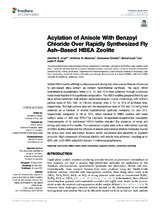Acylation of anisole with benzoyl chloride over rapidly synthesized fly ash–based hbea zeolite
| dc.contributor.author | Ameh, Alechine E. | |
| dc.contributor.author | Musyoka, Nicholas M. | |
| dc.contributor.author | Oyekola, Oluwaseun | |
| dc.date.accessioned | 2021-11-11T12:10:42Z | |
| dc.date.available | 2021-11-11T12:10:42Z | |
| dc.date.issued | 2021 | |
| dc.identifier.citation | Ameh, A. E. et al. (2021). Acylation of anisole with benzoyl chloride over rapidly synthesized fly ash–based hbea zeolite. Frontiers in Chemistry 9,683125. 10.3389/fchem.2021.683125 | en_US |
| dc.identifier.issn | 2296-2646 | |
| dc.identifier.uri | 10.3389/fchem.2021.683125 | |
| dc.identifier.uri | http://hdl.handle.net/10566/7007 | |
| dc.description.abstract | Stable HBEA zeolite with high surface area and strong acid sites was synthesized from coal fly ash–based silica extract via indirect hydrothermal synthesis. The rapid HBEA hydrothermal crystallization times of 8, 10, and 12 h were achieved through a reduced molar water fraction in the synthesis composition. The HBEA zeolites prepared from fly ash silica extract exhibited well-defined spheroidal-shaped crystal morphology with uniform particle sizes of 192, 190, or 239 nm obtained after 8, 10, or 12 h of synthesis time, respectively. The high surface area and the microporous area of 702 and 722 m2 /g were achieved as a function of shorter hydrothermal synthesis durations (10 and 24 h, respectively) compared to 48 or 72 h, which resulted in HBEA zeolites with lower surface areas of 538 and 670 m2 /g. Likewise, temperature-programmed desorption measurements of fly ash–based HBEA zeolites revealed the presence of weak and strong acid sites in the zeolite. | en_US |
| dc.language.iso | en | en_US |
| dc.publisher | Frontiers Media | en_US |
| dc.subject | Coal fly ash | en_US |
| dc.subject | HBEA zeolite | en_US |
| dc.subject | Molar composition | en_US |
| dc.subject | Acylation reaction | en_US |
| dc.subject | Acid | en_US |
| dc.subject | Chemistry | en_US |
| dc.title | Acylation of anisole with benzoyl chloride over rapidly synthesized fly ash–based hbea zeolite | en_US |
| dc.type | Article | en_US |

